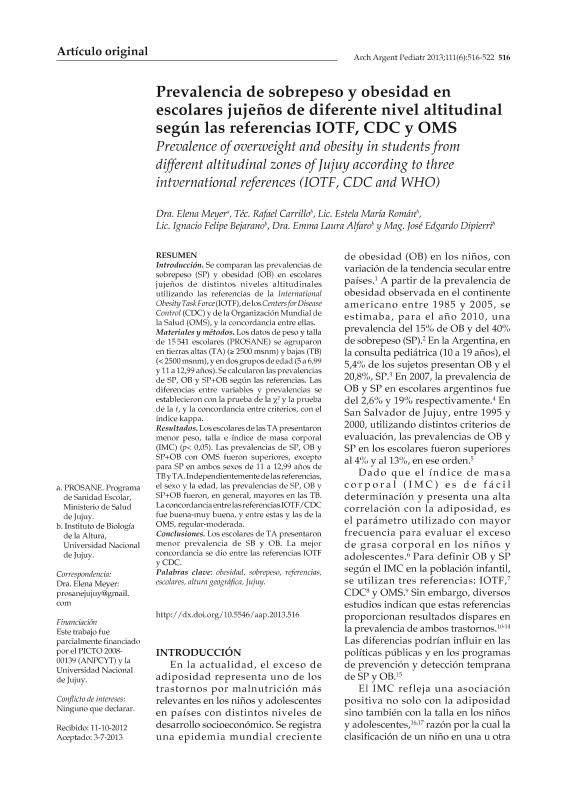Artículo
Introducción. Se comparan las prevalencias de sobrepeso (SP) y obesidad (OB) en escolares jujeños de distintos niveles altitudinales utilizando las referencias de la International Obesity Task Force (IOTF), de los Centers for Disease Control (CDC) y de la Organización Mundial de la Salud (OMS), y la concordancia entre ellas. Materiales y métodos. Los datos de peso y talla de 15 541 escolares (PROSANE) se agruparon en tierras altas (TA) (≥ 2500 msnm) y bajas (TB) (< 2500 msnm), y en dos grupos de edad (5 a 6,99 y 11 a 12,99 años). Se calcularon las prevalencias de SP, OB y SP+OB según las referencias. Las diferencias entre variables y prevalencias se establecieron con la prueba de la χ2 y la prueba de la t, y la concordancia entre criterios, con el índice kappa. Resultados. Los escolares de las TA presentaron menor peso, talla e índice de masa corporal (IMC) (p< 0,05). Las prevalencias de SP, OB y SP+OB con OMS fueron superiores, excepto para SP en ambos sexos de 11 a 12,99 años de TB y TA. Independientemente de las referencias, el sexo y la edad, las prevalencias de SP, OB y SP+OB fueron, en general, mayores en las TB. La concordancia entre las referencias IOTF/CDC fue buena-muy buena, y entre estas y las de la OMS, regular-moderada. Conclusiones. Los escolares de TA presentaron menor prevalencia de SB y OB. La mejor concordancia se dio entre las referencias IOTF y CDC. Introduction: Prevalences of overweight and obesity in students from different altitudinal zones of Jujuy are compared using the International Obesity Task Force (IOTF), the Centers for Disease Control (CDC) and the World Health Organization (WHO) references, and the agreement among them. Material and Methods: Weight and height data from 15 541 students were grouped in highlands (HL) (≥2500 MASL) and lowlands (LL) (<2500 MASL) and in two age groups (5-6.99 years old and 11-12.99 years old). Overweight and obesity prevalences were calculated according to the different references. The differences in outcome measures and prevalences were established using the ?2 test and the t test, and agreement among the criteria was calculated using the kappa index. Results: Students from the HL had lower weight, height and body mass index (BMI) values (p< 0.05). Overweight and obesity prevalences compared to the WHO reference were higher, except for overweight in students of both sexes, from 11 to 12.99 years old, from the HL and the LL. Regardless of the references, gender and age, overweight and obesity prevalences were generally higher in the LL. Agreement between the IOTF and the CDC was good-very good, and agreement among them and the WHO was fair-moderate. Conclusions: Students from the HL had a lower overweight and obesity prevalence. The greatest agreement was observed between the IOTF and the CDC references.
Prevalencia de sobrepeso y obesidad en escolares jujeños de diferente nivel altitudinal según las referencias IOTF, CDC y OMS
Título:
Prevalence of overweight and obesity in students from different altitudinal zones of jujuy according to three international references (IOTF, CDC and WHO)
Elena, Meyer; Carrillo, Rafael Angel; Román, Estela María ; Bejarano, Ignacio Felipe; Alfaro Gómez, Emma Laura
; Bejarano, Ignacio Felipe; Alfaro Gómez, Emma Laura ; Dipierri, Jose Edgardo
; Dipierri, Jose Edgardo
 ; Bejarano, Ignacio Felipe; Alfaro Gómez, Emma Laura
; Bejarano, Ignacio Felipe; Alfaro Gómez, Emma Laura ; Dipierri, Jose Edgardo
; Dipierri, Jose Edgardo
Fecha de publicación:
12/2013
Editorial:
Sociedad Argentina de Pediatría
Revista:
Archivos Argentinos de Pediatría
ISSN:
0325-0075
e-ISSN:
1668-3501
Idioma:
Español
Tipo de recurso:
Artículo publicado
Clasificación temática:
Resumen
Palabras clave:
ALTITUDINAL ZONATION
,
OBESITY
,
OVERWEIGHT
,
REFERENCES
,
STUDENTS
Archivos asociados
Licencia
Identificadores
Colecciones
Articulos(SEDE CENTRAL)
Articulos de SEDE CENTRAL
Articulos de SEDE CENTRAL
Citación
Elena, Meyer; Carrillo, Rafael Angel; Román, Estela María; Bejarano, Ignacio Felipe; Alfaro Gómez, Emma Laura; et al.; Prevalencia de sobrepeso y obesidad en escolares jujeños de diferente nivel altitudinal según las referencias IOTF, CDC y OMS; Sociedad Argentina de Pediatría; Archivos Argentinos de Pediatría; 111; 6; 12-2013; 516-522
Compartir
Altmétricas



